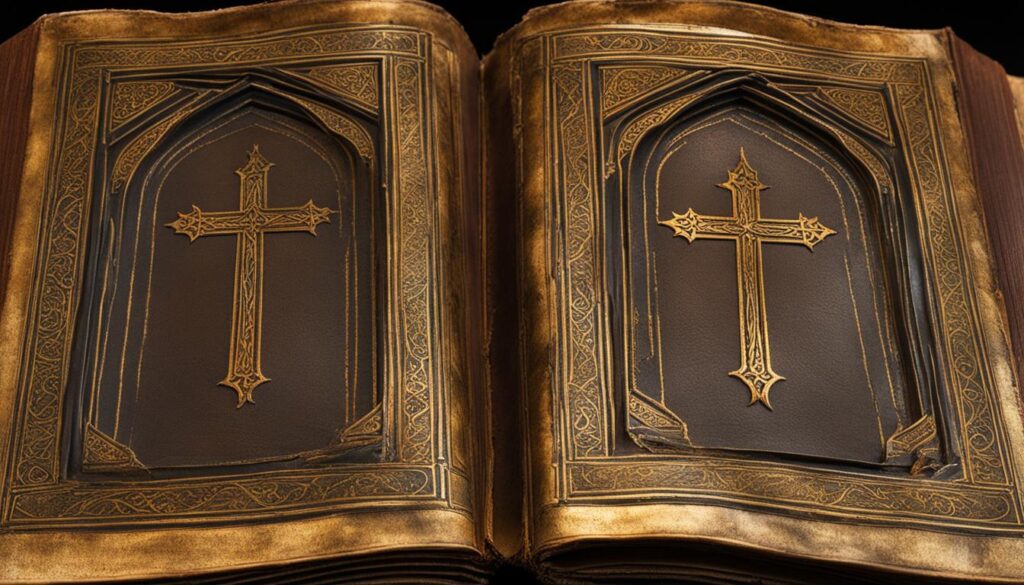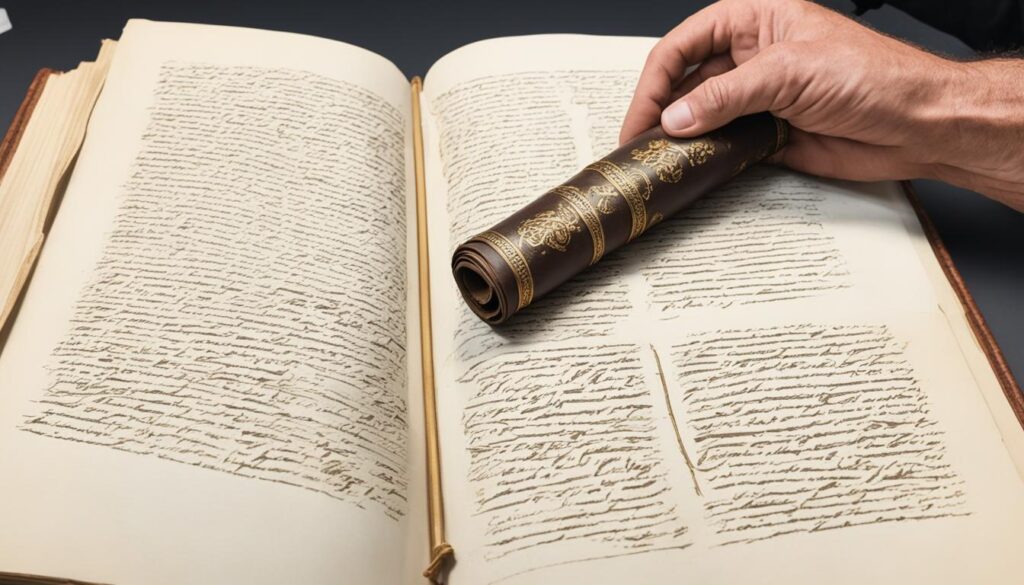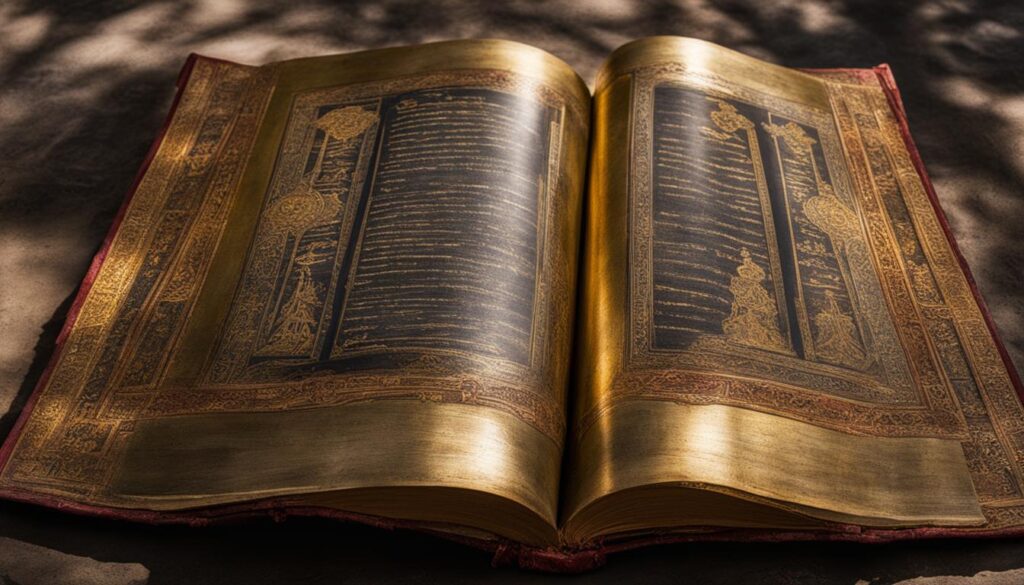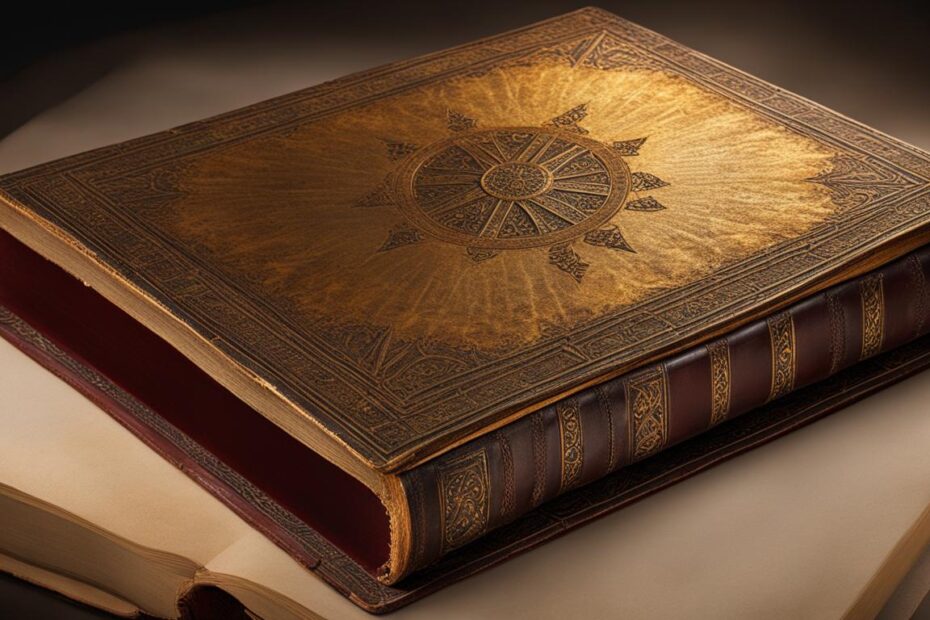The history of prayer books is a captivating tapestry that takes us on a remarkable journey spanning centuries. From ancient manuscripts to modern publications, prayer books have been a guiding light in spiritual practices. By delving into the origins and development of these sacred texts, we unravel the rich tapestry of tradition and spiritual guidance they offer.
Key Takeaways:
- Prayer books have a rich history that dates back centuries.
- They have played a significant role in guiding spiritual practices.
- Exploring the origins of prayer books allows us to understand the traditions and wisdom they embody.
- Prayer books have evolved over time to meet the changing needs and practices of believers.
- Studying historical prayer books helps us gain insights into the beliefs and values of different communities.
The Origins of Jewish Prayer
Jewish prayer has a deep-rooted history, with its origins dating back to biblical times. The Siddur, the Jewish prayer book, contains prayers that have been passed down through generations. Delving into the stories behind these prayers, such as the Shema and Tehillim, allows us to discover the ancient origins of Jewish prayer and the meaning behind each prayer.
The Jewish people have a long-standing tradition of prayer, which holds immense significance in their religious and cultural practices. Prayer serves as a means of connecting with the divine, expressing gratitude, seeking guidance, and finding solace in times of need. It is a powerful tool that nurtures the spiritual journey of individuals and the community as a whole.
“The Siddur, containing prayers for various occasions, is a treasure trove of Jewish culture and heritage, encapsulating the profound devotion of generations past.”
The Siddur, meticulously crafted over centuries, is a testament to the enduring power of Jewish prayer. It encompasses a wide range of prayers, rituals, and blessings, catering to different aspects of Jewish life. From daily prayers to holiday traditions and lifecycle events, the Siddur provides a comprehensive guide for Jewish worship and spiritual connection.

Each prayer within the Siddur carries a story, a history, and a purpose. The Shema, for example, is a foundational prayer recited twice daily, declaring the oneness of God and affirming the central tenets of Jewish faith. Its origins trace back to biblical times and serve as a spiritual anchor for countless generations.
The Tehillim, also known as Psalms, is a collection of poetic prayers attributed to King David. These timeless expressions of joy, pain, and praise resonate with the human experience and provide solace during times of emotional turmoil. The Tehillim continues to be recited by Jews around the world, offering comfort and inspiration.
Jewish prayer is not bound by time or place. It is a continuous thread that connects individuals to their ancestors and to God. Through prayer, Jews express gratitude for blessings, seek forgiveness, ask for guidance, and engage in deep introspection. The Siddur serves as a guide, a roadmap, and a companion on this spiritual journey.
The Significance of Traditional Prayers
Traditional prayers hold immense significance in various faiths and denominations. These prayers, often written centuries ago, offer profound insights and a connection to believers throughout history. By including traditional prayers in prayer books, individuals can participate in a shared experience of prayer and tap into the wisdom of those who have come before.
“The wisdom of our ancestors is encapsulated in these traditional prayers. They serve as a bridge, connecting us to the spiritual journey of those who preceded us.”
Traditional prayers carry a deep sense of continuity and are rooted in the collective faith experiences of countless generations. They provide a framework for expressing devotion, gratitude, and supplication, leading believers to a deeper understanding of their faith. In today’s fast-paced world, where distractions abound, engaging with traditional prayers creates a space for reflection, contemplation, and a renewed connection with the divine.
The inclusion of traditional prayers in prayer books not only enables individuals to draw strength from the prayers themselves, but also fosters a sense of community and unity among believers. When reciting these prayers, individuals become part of a timeless tradition, joining countless others who have found solace, guidance, and inspiration in the same words throughout history.
A Source of Comfort and Guidance
Traditional prayers offer a sense of familiarity and stability, providing comfort during challenging times. In moments of despair, reciting these prayers can bring solace, reminding believers that they are never alone in their struggles. These prayers serve as a source of guidance, offering timeless wisdom that transcends the limitations of any particular era. They serve as beacons of hope, inspiring individuals to navigate life’s complexities with faith, resilience, and a renewed sense of purpose.
Moreover, traditional prayers can deepen spiritual practices and create a profound connection with the divine. They provide a framework for personal reflection, allowing individuals to express their deepest desires, confess their shortcomings, and seek forgiveness. Through the repetition of these prayers, believers enter into a spiritual discipline that nurtures their relationship with the divine and fosters personal growth.
Embracing the Wisdom of the Past
By including traditional prayers in prayer books, we acknowledge and embrace the wisdom of our spiritual predecessors. These prayers have withstood the test of time, carrying the voices and aspirations of countless individuals who have sought divine communion. They embody the collective faith experiences of generations past and present, revealing enduring truths about the human condition and our relationship with the divine.
Engaging with traditional prayers allows us to enter into the sacred space of our shared spiritual heritage. It opens the door to a deeper understanding of our own faith traditions and the interconnectedness of humanity. Through the ritual and repetition of these prayers, we become part of a greater whole, joining a chorus of voices that spans across time and space.

Evolution of Prayer Books
Prayer books have undergone a remarkable evolution over the centuries, adapting to the changing needs and practices of believers. From ancient handwritten manuscripts to modern printed editions, the development of prayer books has been influenced by various factors including religious practices, cultural and historical events, and advancements in printing technology.
In the earlier stages of prayer book development, scribes meticulously transcribed prayers by hand, often embellishing them with intricate illustrations and ornamentation. These beautifully crafted manuscripts were treasured heirlooms, handed down from one generation to the next, and served as sacred guides for personal and communal worship.
With the invention of the printing press in the 15th century, the production and dissemination of prayer books became more accessible. The ability to mass-produce prayer books revolutionized religious practices, allowing larger numbers of believers to engage in structured and consistent prayer.
As the popularity of prayer books grew, so did the need for standardized texts. Religious leaders and scholars compiled collections of prayers, carefully selecting and organizing them to reflect the beliefs and practices of their respective faiths. These compilations provided a cohesive framework for prayer, guiding individuals in their spiritual journeys and fostering a sense of unity among believers.
Throughout history, prayer books have also been influenced by cultural and historical events. Rituals and prayers were adapted to reflect the changing times, incorporating new themes and addressing emerging challenges. This adaptability ensured that prayer books remained relevant and meaningful to believers in different eras.
The evolution of prayer books has also been shaped by advancements in printing technology. Improved printing techniques allowed for the inclusion of visuals, such as beautiful illustrations and decorative elements, enhancing the aesthetics and overall experience of prayer. Additionally, the availability of different translations and versions of prayer books catered to the diverse needs of individuals, making prayer accessible to a wider audience.
“The evolution of prayer books reflects the evolving needs and practices of believers, showcasing the ongoing relevance of prayer in a changing world.”
Today, prayer books continue to evolve in response to the diverse spiritual needs and preferences of believers. Digital formats and online platforms have emerged, providing new ways to access and engage with prayers. These technological advancements have expanded the reach and accessibility of prayer books, allowing individuals around the world to connect with their spiritual traditions.
Evolution of Prayer Books
| Period | Key Developments |
|---|---|
| Ancient Times | – Handwritten manuscripts embellished with illustrations – Prayers passed down through oral tradition |
| 15th Century | – Invention of the printing press – Mass production of prayer books |
| Post-Reformation | – Standardization of prayer texts – Incorporation of new themes and adaptations |
| Modern Era | – Inclusion of visuals and decorative elements – Advancements in printing technology – Digital formats and online accessibility |

The Historical Significance of Prayer Books
Prayer books hold a profound historical significance, offering a window into the religious and cultural practices of different eras. These sacred artifacts provide valuable insights into the beliefs, values, and rituals of communities, serving as a testament to the enduring power of prayer.
Through the study of historical prayer books, we gain a deeper understanding of the lives and experiences of those who came before us. Each page bears witness to the hopes, dreams, and struggles of individuals seeking solace, guidance, and connection with the divine.
One remarkable aspect of prayer books is their ability to transcend time, connecting people across generations. As we hold these ancient texts in our hands, we are reminded of the countless souls who have turned to prayer in times of joy and sorrow, in moments of celebration and despair.
Prayer books are not mere collections of religious texts; they are vessels that carry the echoes of centuries, whispering prayers spoken by generations past.
The historical significance of prayer books is not confined to any specific religion or tradition. Whether it be the Siddur in Judaism, the Book of Common Prayer in Christianity, or the Quran in Islam, each religious tradition has its own distinct prayer book with a unique historical narrative.
By delving into the history of prayer books, we unearth a tapestry of human experiences, a shared longing for connection with the divine. These books serve as a bridge that spans time and space, linking us to the spiritual hopes and aspirations of our ancestors.
Prayer Books: A Testament to Faith
When we examine historical prayer books, we witness not only the personal devotion of individuals but also the collective faith of entire communities. These texts showcase the unwavering commitment to religion, the resilience in times of adversity, and the unwavering hope that sustained believers across centuries.
Each prayer book bears witness to a story of faith—a testament to the enduring quest for spiritual connection and meaning. As we explore the historical significance of these books, we gain a profound appreciation for the reverence and devotion that has woven its way through the tapestry of human history.
| Religion | Prayer Book | Time Period | Key Features |
|---|---|---|---|
| Judaism | Siddur | Ancient to Present | Contains prayers, blessings, and liturgical poems that reflect Jewish tradition and spiritual practices. |
| Christianity | Book of Common Prayer | 16th Century to Present | Includes various prayers, services, and readings used in Anglican and other Christian denominations. |
| Islam | Quran (Mus’haf) | 7th Century to Present | Consists of the revelations received by Prophet Muhammad and is considered the holy book of Islam. |
These prayer books, spanning different faith traditions, offer glimpses into the lives and devotion of millions of individuals throughout history. They are a testament to the power of prayer, transcending time, language, and cultural divides.
As we explore the historical significance of prayer books, we are invited to reflect on our own spiritual journey, drawing inspiration from the enduring legacy of those who have gone before us. These cherished texts serve as a reminder that the yearnings of the human spirit—hope, faith, and connection—remain timeless and universal.

Prayer Book Origins in Different Faith Traditions
Prayer books are not limited to the Jewish tradition; they also play a significant role in other faith traditions like Christianity and Islam. Each tradition has its unique collection of prayers, reflecting their distinct beliefs and practices.
Christianity, for instance, embraces the use of prayer books to guide believers in their spiritual journey. The Book of Common Prayer, used by various Christian denominations, contains liturgies, psalms, and prayers that have been influential for centuries.
In Islam, Muslims engage in prayer using a collection of prayers known as the Qur’an, which serves as their primary source of guidance. This holy book includes a comprehensive compilation of prayers that are recited during different times of the day and on special occasions.

Exploring the origins of prayer books in different faith traditions offers a broader perspective on the role of prayer and highlights the diversity of approaches to spiritual practices. It reminds us that prayer is a universal language that connects individuals across different cultures and beliefs.
The Prayer Book Timeline
Tracing the evolution of prayer books over time reveals a fascinating timeline of the development of religious traditions. From the earliest known prayer books to modern-day publications, the prayer book timeline illustrates the changes in content, design, and accessibility of prayer books.
Throughout history, prayer books have undergone significant transformations, adapting to the needs and practices of believers. The timeline provides a visual representation of how prayer books have evolved and progressed, reflecting the growth and continuity of prayer practices.
Key Milestones in the Prayer Book Timeline
- Earliest known prayer books: These ancient manuscripts provide insights into the early practices and beliefs of religious communities.
- Medieval illuminated prayer books: Lavishly decorated and adorned with intricate artwork, these prayer books symbolized the devotion and reverence of believers during the Middle Ages.
- Reformation and printed prayer books: The advent of the printing press enabled the mass production of prayer books, making them more accessible to a wider audience and facilitating religious reforms.
- Modern adaptations: With advancements in technology, prayer books have embraced digital formats, allowing for convenience and portability in an increasingly interconnected world.
“The prayer book timeline highlights the resilience and adaptability of prayer practices, as they have thrived and evolved alongside changing religious, cultural, and technological landscapes.”
Understanding the prayer book timeline not only deepens our appreciation for the historical significance of these sacred texts but also illuminates the ways in which prayer remains a vital and enduring practice in various traditions.
The Significance of the Prayer Book Timeline
The prayer book timeline offers valuable insights into the development and continuity of religious practices. By studying this timeline, we gain a better understanding of the shaping forces that have influenced prayer book content, design, and accessibility throughout history.
| Time Period | Characteristics |
|---|---|
| Ancient Times | Oral prayer traditions, earliest written manuscripts |
| Middle Ages | Elaborate illuminated manuscripts, handwritten copies |
| Reformation | Standardized prayers, printed editions, translations |
| Modern Era | Digital formats, inclusive language, personalized editions |
The prayer book timeline also demonstrates how prayer books have served as not only spiritual guides but also historical artifacts. They preserve the beliefs, traditions, and values of different periods, offering a window into the lives and experiences of believers throughout time.
As we navigate the prayer book timeline, we gain a broader perspective on the influence of prayer on various cultures and traditions, appreciating the rich tapestry of spiritual practices that have shaped our world today.
Prayer Books as Tools for Spiritual Connection
Prayer books are more than just written words on a page; they are powerful tools that facilitate a deep and profound spiritual connection. These sacred texts provide a framework for prayer, guiding individuals on a contemplative journey that leads to a stronger relationship with the divine. Through the pages of prayer books, believers can express their spiritual understanding, find solace, and connect with their religious traditions, forging a deeper connection with the spiritual realm.
When utilizing prayer books, individuals embark on a meaningful and intentional prayer practice. The carefully crafted prayers and rituals within the pages of these books serve as signposts, guiding practitioners toward a more authentic and profound spiritual experience. Whether reciting centuries-old prayers or engaging in personal reflections, prayer books offer a structured approach to prayer that encourages focus, meditation, and self-discovery.
Within the sacred pages, individuals can explore a wide range of prayers, encompassing various aspects of life and spirituality. From prayers of gratitude and forgiveness to prayers for guidance and healing, prayer books cater to the diverse needs and aspirations of believers. This vast array of prayers allows individuals to find resonance with their personal experiences and connect with the divine in a deeply personal way.
The power of prayer books lies not only in the carefully chosen words they contain, but also in the intentions and emotions they evoke within us. They serve as a spiritual companion, offering solace during challenging times and amplifying our joy during moments of celebration. Through prayer books, we open a channel to the divine, allowing its wisdom and guidance to flow into our lives.
By regularly engaging with prayer books, believers create a rhythm of spiritual connection in their daily lives. These books become a cornerstone of spiritual practice, providing a sense of routine and grounding in a fast-paced world. The act of opening a prayer book and immersing oneself in its words and rituals cultivates a sacred space, allowing individuals to pause, reflect, and connect with something greater than themselves.
Prayer books serve as bridges between the physical and spiritual realms, helping individuals transcend their everyday existence and touch the divine. In the quiet moments spent immersed in prayer, believers find solace, guidance, and a profound sense of connection. These books provide a tangible reminder of the timeless wisdom and teachings that have been passed down through generations, allowing us to tap into a collective spiritual consciousness.
By embracing prayer books as tools for spiritual connection, individuals can cultivate a deeper relationship with their faith, experience profound moments of transcendence, and navigate life’s challenges with grace. Through the rituals, guidance, and sacred words contained within these books, believers can embark on a transformative journey that enriches their spiritual lives and instills a greater sense of purpose and meaning.
The Transformative Power of Prayer Books
Prayer books possess a unique and transformative power that can profoundly impact the lives of individuals. Through the words and rituals contained within these sacred texts, believers can find solace, guidance, and inspiration. The transformative power of prayer books lies in their ability to connect individuals with something greater than themselves, fostering a deep sense of spiritual connection.
During difficult times, prayer books offer a source of comfort and strength. They provide a refuge from life’s challenges, allowing individuals to find peace and reassurance in their faith. Through heartfelt prayers and contemplative practices, prayer books become a sanctuary where individuals can seek solace and find the strength to overcome adversity.
Moreover, prayer books serve as a valuable guide in decision-making. They offer prayers and meditations that help individuals navigate complex choices and dilemmas. By turning to the wisdom found within prayer books, individuals can find clarity, discernment, and guidance to make choices aligned with their values and spiritual beliefs.
“Prayer is not asking. It is a longing of the soul. It is daily admission of one’s weakness. It is better in prayer to have a heart without words than words without a heart.” – Mahatma Gandhi
Furthermore, prayer books provide opportunities for moments of transcendence. Through reverent and mindful engagement with the prayers and rituals contained within the pages, individuals can experience profound connections with the divine. This transformative experience can uplift the spirit, inspire personal growth, and deepen one’s understanding of their place in the world.
The transformative power of prayer books extends beyond personal growth and spiritual connection. It has the potential to foster empathy, compassion, and unity among individuals and communities. Through shared rituals and prayers found within prayer books, believers can come together, forging bonds that transcend differences and strengthening the fabric of faith communities.
In summary, prayer books possess a transformative power that reaches deep into the hearts and souls of individuals. From providing comfort during challenging times to offering guidance in decision-making and facilitating moments of transcendence, prayer books connect believers with something greater than themselves. They are precious tools that can bring solace, inspiration, and profound spiritual transformation to individuals as they embark on their personal journeys of faith.
Reflecting on Prayer Book History
Reflecting on prayer book history allows us to appreciate the profound impact of prayer books on religious practices and the lives of believers. These sacred texts have stood the test of time, offering guidance and inspiration to countless individuals throughout history. By delving into the history of prayer books, we gain a deeper understanding of their enduring value and the role they play in our spiritual traditions.
Prayer books have been a source of comfort, solace, and guidance for centuries. They have provided believers with a framework for prayer, a collection of sacred words that can be recited to connect with the divine. Through the study of prayer book history, we can recognize the universal human desire for spiritual connection and the ways in which prayer books have fulfilled that need across different cultures and faith traditions.
“Prayer books are like windows into the past, offering glimpses of the religious practices and beliefs of our ancestors. They bear witness to the enduring power of prayer and its ability to sustain and transform lives.”
As we reflect on prayer book history, we come to understand that these texts are not static, but have evolved alongside the changing needs and practices of believers. From handwritten manuscripts to beautifully printed editions, prayer books have adapted to technological advancements while preserving their timeless wisdom. Each new iteration of a prayer book tells a story of belief, devotion, and the desire to connect with the divine.
Evolution of Prayer Book Formats
| Time Period | Format | Features |
|---|---|---|
| Ancient Times | Scroll | Handwritten, portable |
| Medieval Period | Manuscript | Illuminated, decorative |
| 16th Century | Printed Book | Accessible, standardized |
| Modern Era | Digital | Interactive, customizable |
Through prayer books, we can connect with the spiritual traditions of our ancestors, drawing inspiration and guidance from their collective wisdom. The words within these sacred texts have the power to transform our lives, providing us with a sense of purpose, peace, and hope. Understanding the history of prayer books deepens our appreciation for their significance and invites us to engage more fully with our own prayer practices.
Conclusion
The journey through prayer book history is a profound exploration of spiritual guidance and tradition. From the ancient origins of prayers to the evolution of prayer books over time, these sacred texts hold significant meaning and importance. Prayer books serve as powerful tools that foster spiritual connection, offer transformative power, and provide a sense of continuity with religious traditions.
Embarking on a journey through prayer book history allows us to deepen our understanding of prayer and our own spiritual practices. By delving into the rich tapestry of tradition and wisdom contained within prayer books, we can cultivate a stronger connection with the divine and seek solace in times of difficulty. These texts serve as a reminder of the enduring value and relevance of prayer in our lives.
Reflecting on prayer book history offers insights into the evolution of religious practices and the impact of prayer on individuals and communities throughout time. It is a reminder that prayer transcends culture, language, and time, serving as an unbroken thread that connects believers across generations. By embracing the lessons and guidance found within prayer books, we can enrich our spiritual lives and find renewed inspiration in our daily prayers.
FAQ
What is the history of prayer books?
The history of prayer books is a journey that spans centuries, from ancient manuscripts to modern publications. Prayer books have evolved over time to meet the changing needs and practices of believers.
What is the origin of Jewish prayer?
Jewish prayer has ancient origins dating back to biblical times. The Siddur, the Jewish prayer book, contains prayers that have been passed down through generations.
What is the significance of traditional prayers?
Traditional prayers hold immense significance in various faiths and denominations. They offer profound insights and a connection to believers throughout history, providing a shared experience of prayer.
How have prayer books evolved over time?
Prayer books have evolved from handwritten manuscripts to printed books, adapting to the changing needs and practices of believers. The development of prayer books reflects shifts in religious practices and advancements in printing technology.
What is the historical significance of prayer books?
Prayer books hold historical significance as artifacts that shed light on the religious and cultural practices of different time periods. They provide valuable insights into the beliefs and values of communities throughout history.
What are the prayer book origins in different faith traditions?
Prayer books exist in various faith traditions beyond Judaism, including Christianity and Islam. Each tradition has its own unique prayer book or collection of prayers, highlighting the diversity of approaches to prayer.
What is the prayer book timeline?
The prayer book timeline illustrates the evolution of prayer books over time, showcasing the changes in content, design, and accessibility. It provides a fascinating glimpse into the development of religious traditions.
How do prayer books foster spiritual connection?
Prayer books serve as powerful tools for fostering spiritual connection, providing a framework for meaningful and contemplative engagement with one’s faith. They guide individuals in prayer and help deepen their relationship with the divine.
What is the transformative power of prayer books?
Prayer books have the potential to transform lives by offering guidance, solace, and inspiration. Through the words and rituals contained within prayer books, individuals can find comfort, seek guidance, and experience moments of transcendence.
How does reflecting on prayer book history impact spiritual practices?
Reflecting on prayer book history allows individuals to appreciate the profound impact of prayer books on religious practices and the lives of believers. It helps develop a deeper understanding of prayer and creates renewed inspiration in one’s prayer practices.








